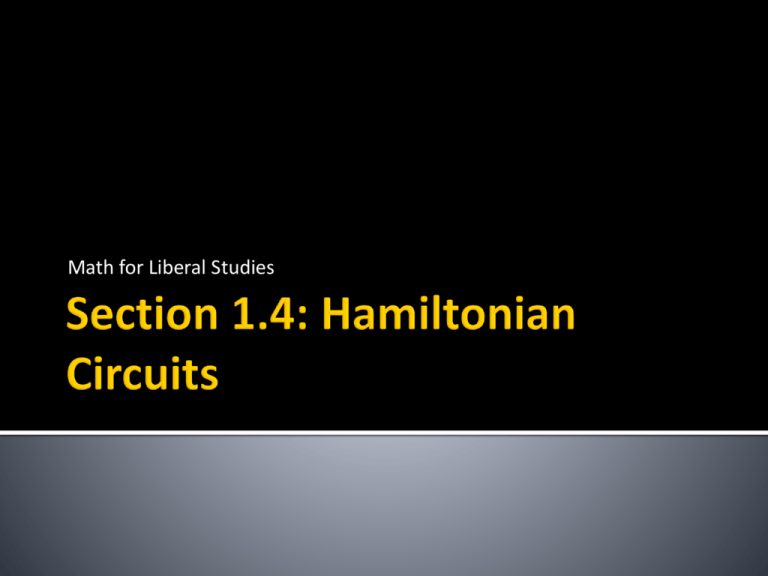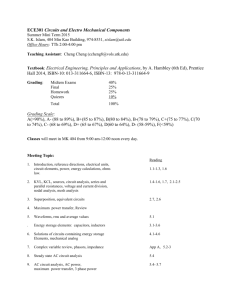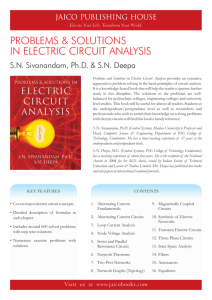Section 1.4: Hamiltonian Circuits
advertisement

Math for Liberal Studies A postal worker needs to take several packages from the post office, deliver them to the four locations shown on the map, and then return to the office The postal worker wants to know the best route to take to deliver the packages Do we want to use Euler circuits to solve this problem? This is called a complete graph because every pair of vertices is connected by an edge This represents our ability to travel from any point to any other We don’t need an Euler circuit, which would have us travel along each edge We just need to visit each vertex once and then return to our starting point A Hamiltonian circuit is a circuit that visits each vertex exactly once, except for the starting vertex, which is the same as the ending vertex We want to find the circuit that has the lowest total “cost” Here “cost” might mean travel time distance monetary cost etc. 1. Examine all possible Hamiltonian circuits 2. Compute the total cost of all of these circuits 3. Choose the circuit with the lowest total cost Suppose you want to take a road trip for Spring Break You want to start from Shippensburg (S), and visit Harrisburg (H), Lancaster (La), and Lewisburg (Le) in some order before returning to Ship From Shippensburg, we have three choices for our first destination From each of these possibilities, we now have two choices Next, we only have one choice remaining And finally, we must return to S Circuit S – H – La – Le – S S – H – Le – La – S S – La – H – Le – S S – La – Le – H – S S – Le – H – La – S S – Le – La – H – S Cost 43 + 39 + 100 + 99 = 281 43 + 62 + 100 + 79 = 284 79 + 39 + 62 + 99 = 279 79 + 100 + 62 + 43 = 284 99 + 62 + 39 + 79 = 279 99 + 100 + 39 + 43 = 281 Circuit S – H – La – Le – S S – H – Le – La – S S – La – H – Le – S S – La – Le – H – S S – Le – H – La – S S – Le – La – H – S Cost 43 + 39 + 100 + 99 = 281 43 + 62 + 100 + 79 = 284 79 + 39 + 62 + 99 = 279 79 + 100 + 62 + 43 = 284 99 + 62 + 39 + 79 = 279 99 + 100 + 39 + 43 = 281 If we draw these two circuits, we find that in fact they are the same One circuit is the reverse of the other, so the total costs are the same In fact, while it looked like there were 6 total circuits, really there were only 3 The brute force method is good because we know for sure we find the best possible answer The biggest disadvantage of the brute force method is that the total number of circuits gets very large if we look at graphs with more vertices In our example, we had 4 total vertices So from our starting point, we had 3 choices, then we had 2 choices, then 1 choices, then no choice but to go back to the start That gave us 3 2 1 = 6 total circuits But really there were only half that: 3 circuits What if we had 5 total vertices? We would have 4 choices, then 3, then 2, then 1, then back to the start That gives us 4 3 2 1 = 24 total circuits And again there would only really be half that: 12 circuits The calculation we are doing is a common one in mathematics, called factorial The factorial of a whole number n is the product of all the whole numbers between 1 and n Factorial is written with an exclamation point: n! = n (n – 1) 3 2 1 For example: 5! = 5 4 3 2 1 = 120 Factorial numbers grow very quickly 7! = 5040 This means that if we had tried to solve our road trip problem with 8 locations instead of 4, we would have had to consider over five thousand circuits instead of just six Fishermen laying and collecting traps from certain locations (“Deadliest Catch”) Vending machine company collecting money from various machines around campus School bus picking up special-needs children from certain houses in a town Programming a robot to spot-weld certain locations on a car frame Use the brute-force method to find the lowest-cost Hamiltonian circuit for this graph 1. Examine all possible Hamiltonian circuits 2. Compute the total cost of all of these circuits 3. Choose the circuit with the lowest total cost First we make a “tree diagram” that lists all of the Hamiltonian circuits Notice that we chose A as our starting point, but really we could have started anywhere Now we add up the total cost of each circuit Circuit A–B–C–D–A A–B–D–C–A A–C–B–D–A A–C–D–B–A A–D–B–C–A A–D–C–B–A Cost 8 + 9 + 12 + 7 = 36 8 + 6 + 12 + 10 = 36 10 + 9 + 6 + 7 = 32 10 + 12 + 6 + 8 = 36 7 + 6 + 9 + 10 = 32 7 + 12 + 9 + 8 = 36 Notice that we get every circuit twice Finally, we choose the cheapest circuit Circuit A–B–C–D–A A–B–D–C–A A–C–B–D–A A–C–D–B–A A–D–B–C–A A–D–C–B–A Cost 8 + 9 + 12 + 7 = 36 8 + 6 + 12 + 10 = 36 10 + 9 + 6 + 7 = 32 10 + 12 + 6 + 8 = 36 7 + 6 + 9 + 10 = 32 7 + 12 + 9 + 8 = 36





